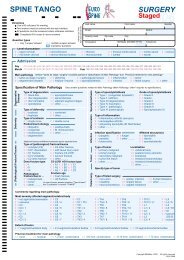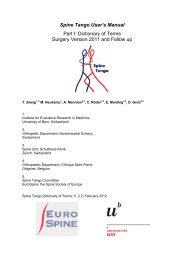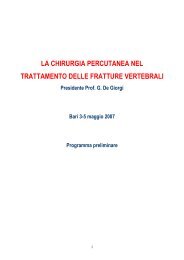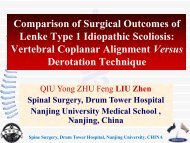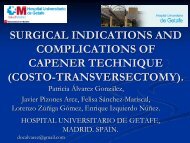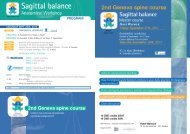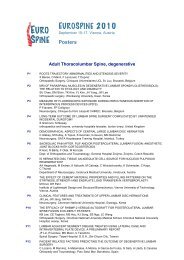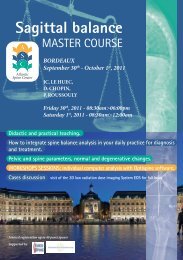Eurospine Spine Tango - The Spine Society of Europe
Eurospine Spine Tango - The Spine Society of Europe
Eurospine Spine Tango - The Spine Society of Europe
- No tags were found...
You also want an ePaper? Increase the reach of your titles
YUMPU automatically turns print PDFs into web optimized ePapers that Google loves.
<strong>Eurospine</strong> <strong>Spine</strong> <strong>Tango</strong><strong>The</strong> international spine registry
Our vision<strong>Spine</strong> surgery is a heavily technology driven medical discipline with alack <strong>of</strong> sufficient evidence for many therapies. Whenever new innovationsenter the market they should be carefully surveyed and monitoredsince neither laboratory testing nor randomised controlled trials providethe final conclusive information about the product performance and itssafety in the multitude <strong>of</strong> the different clinical and post-market settings,i.e. in reality. Accordingly, opinion leaders in spinal surgery recommendconsistent and consequent documentation <strong>of</strong> treatment outcomes andrigorous post-market surveillance <strong>of</strong> implants for adverse events. <strong>Eurospine</strong>,the <strong>Spine</strong> <strong>Society</strong> <strong>of</strong> <strong>Europe</strong> has partnered up with an internationalleader in the field <strong>of</strong> medical registries and has developed a commonlanguage for recording and reporting treatments and outcomes for and<strong>of</strong> spinal pathologies. In order to identify rare adverse events fast and increasethe power <strong>of</strong> our observations, a joint database for all participantsis equally important. This vision triggered the development <strong>of</strong> <strong>Spine</strong><strong>Tango</strong>, the only international spinal registry to date. <strong>Spine</strong> <strong>Tango</strong> canmeanwhile look back at a 10 years history and over 30`000 documentedcases from more than 40 hospitals. We are looking forward to welcomingyou as a contributing new member in this visionary endeavour.E. Munting, MD,head <strong>of</strong> the <strong>Spine</strong> <strong>Tango</strong> committeeContactUniversity <strong>of</strong> BerneInstitute for Evaluative Research in MedicineChristoph Röder, MD PhD MPHMichal Neukamp, MDStauffacherstr. 78CH-3014 Bernechristoph.roeder@memcenter.unibe.chmichal.neukamp@memcenter.unibe.chInfowww.eurospine.org→ click on SPINE TANGO
Why a registry?“All patients must be followed in order to assessthe benefit <strong>of</strong> complications <strong>of</strong> a certain treatment”Ernest Codman, 1931A well run registry communicates valuable information:Quality Management– to assess the quality <strong>of</strong> treatments and implantsDrive Improvement– to benchmark “own” approach against peers’ techniquesProvide Security– verification system for regulatory authorities to reviewPatient Counselling– to provide patients factual evidence <strong>of</strong> treatment choicesFiscal Prudence– to supply invaluable data for cost benefit analysisEarly Warning– alert to implant failures or to trends—negative & positiveSave Time– deliver convenient access to overview <strong>of</strong> operative activities“Documation is considered as indespensablefor surgeon self-assessment and evaluation<strong>of</strong> value <strong>of</strong> the various surgical methods.”Maurice E. Müller, 1963
Why participate in the <strong>Spine</strong> <strong>Tango</strong> registrySimple two page, low complexityquestionnaireQuestionnaire for non-surgical therapieswithin the same projectModern outcome questionnaires for neckand back painYou can add your own data sets andformsSame questionnaire and datastructure for all participating nationsOnline and <strong>of</strong>fline data collectionFull online system using anApplication Service Provider (ASP)National filter modules—nationalweb address, national administrativeautonomy, PC web serverCentralized data pool—consolidation<strong>of</strong> clinical, implant and picture data inone databaseGlobal research network andbackbone for implementation <strong>of</strong>multi center studiesContent developed by<strong>Spine</strong> <strong>Society</strong> <strong>of</strong> <strong>Europe</strong>Institute for Evaluative Researchin Medicine,University <strong>of</strong> BernEasy and convenient to administerand maintainEnables outcome comparison <strong>of</strong> surgicaland conservative treatments in the framework<strong>of</strong> the same registryShort yet comprehensive outcome assessmentfor improved patient complianceCustomized data sets provide morespecialized informationDirect comparisons on national,international and inter-continentalscaleBetter integration into hospital workflowNo local s<strong>of</strong>tware installation ormanagement—seamless updatesSafe in the knowledge it neverleaves your nationalenvironment—identifiable dataremains within national boundariesSaves time—all the data comes in oneconsistent format from one databaseGreater power to your clinical studiesYou are safe in the knowledge thatall systems are based on soundsurgical practice from <strong>Europe</strong>anopinion leadersAcademic clearing house with years <strong>of</strong>experience in building registries—youraccess to constant innovation
QuestionnairesOnline and paper-based data collection and scanning with optical mark readerSurgeon Forms:ST SurgeryST Staged SurgeryST FollowupPatient Forms:COMI BackCOMI Neck
1Statistics and reports324<strong>Spine</strong> <strong>Tango</strong> online statistics1. Query mask for creation <strong>of</strong> patient samples andoutput variables2. Graphical output format3. Table output format<strong>Spine</strong> <strong>Tango</strong> print tool4. Question-answer print formatSoon to come: customizable print templates forgeneration <strong>of</strong> surgical reports and discharge letters
Implant tracking (SEDICO)<strong>The</strong> number and diversity <strong>of</strong> implants available on the market makes ithighly desirable to precisely document the implant used (article number& lot number), and to correlate it with the clinical and radiographic outcomein short-, mid-, and long-term follow-ups. Numerous variables areneeded to describe an implant so precisely as to be able to accuratelyidentify it. This is a very time consuming effort, and hence is not possiblefor daily use in a clinical setting. <strong>The</strong>refore, <strong>Spine</strong> <strong>Tango</strong> has interfaceda barcode-based implant tracking system, which is capable <strong>of</strong> accuratelyidentifying and tracking orthopaedic implants. This system, calledSecure Data Integration Concept (SEDICO), is based on an open partnerconcept with an ultimate goal to integrate all major implant producers intothe system. With SEDICO, all main components used and implantedin a patient are scanned by the OR staff and automatically identified tothe respective case using the medical record number when they areunpacked and handed to the surgeon. <strong>The</strong> scanner downloads the datawhile it sits in its recharge cradle. One set <strong>of</strong> the data is used for orderingand inventory purposes, and another copy, consisting <strong>of</strong> article andlot numbers with other linking parameters, is sent to the clinical documentationsystem. In the event that the SEDICO system is not availablein a hospital, the documentation system also <strong>of</strong>fers an updated electroniccatalogues <strong>of</strong> the major implant producers where the implanted componentscan be searched and linked. Last but not least, possibilities tosimply type-in article numbers or fill-in the implant description <strong>of</strong> otherproducers are also available online.1. SCANScanning <strong>of</strong> theimplant barcode2. TRANSMITTransmission <strong>of</strong> thescanned data3. RECEIVEReception <strong>of</strong> thescanned data at theclearing center7. PROCESSOrder processing by thesupplier4. CONFIRME-mail or fax confirmation sentto the operating theatre orpurchasing department5. INTEGRATE (optional)Integration <strong>of</strong> the order into thehospital’s ERP6. DOCUMENTLinking <strong>of</strong> implant data to clinicaldocumentation
Security<strong>Spine</strong> <strong>Tango</strong> makes use <strong>of</strong> the latest security technology developed forthe MEMdoc documentation portal <strong>of</strong> the University <strong>of</strong> Bern Institute forEvaluative Research in Medicine. <strong>The</strong> model <strong>of</strong> the MEMdoc portal andits module system is designed around the principle <strong>of</strong> data separation.<strong>The</strong> MEMdoc central server, housed at the University <strong>of</strong> Bern, hosts themain application and the central database containing all study definitionsand clinical study data. Satellite MEMdoc-Module servers locatedthroughout the world to store all personal data about users, institutionsand patients. At the core <strong>of</strong> the system is an innovative and patent-pendingarchitecture in which the web browser <strong>of</strong> the client is used as a hubto seamlessly segregate and integrate the data between the MEMdoc-Module and the MEMdoc central server. This design provides tightlyintegrated communication between the servers while increasing thesecurity and privacy <strong>of</strong> both systems. This has been accomplished usinga light weight JSON server and incorporation <strong>of</strong> SSL encryption on eachmodule. Flexible data sharing options have been designed to restrict orexpand data access to suit individual needs. Finally, data consistencyis controlled through systematic validation <strong>of</strong> received data and a rollbackin case <strong>of</strong> errors. Read more about <strong>Spine</strong> <strong>Tango</strong> data security inthe <strong>Spine</strong> <strong>Tango</strong> annual report 2009 or in the <strong>Spine</strong> <strong>Tango</strong> section <strong>of</strong> the<strong>Eurospine</strong> webpage www.eurospine.org




